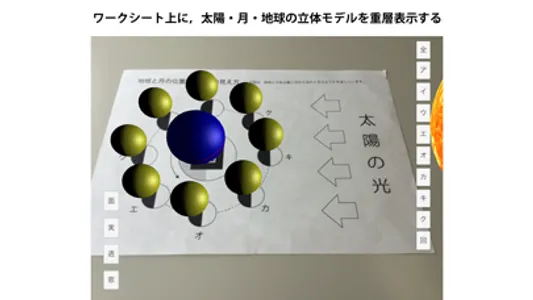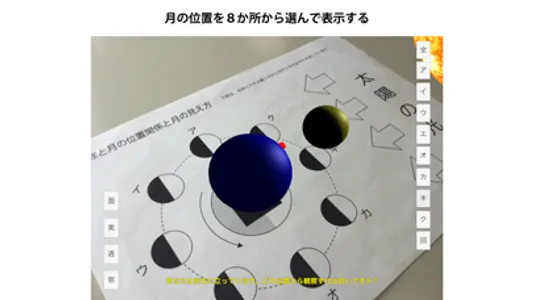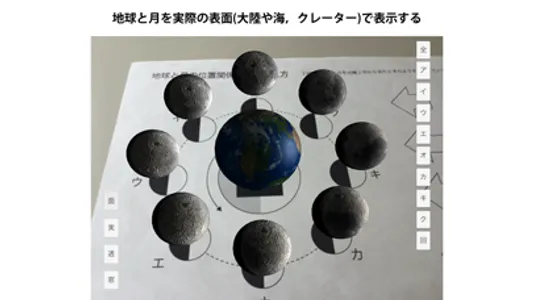Explanation:
An app that displays the waxing and waning of the moon, which are learned in middle school science classes, in Augmented Reality* (AR).
It is very difficult to view the waxing and waning of the moon in a plane view. Therefore, we superimposed a 3D model onto a plan view (hereafter worksheet) from which you can view the sun, moon, and earth from the North Pole. By moving the tablet to the observation point, you can investigate how the moon waxes and wanes.
Main functions
- The 3D models of the sun, moon, and earth are superimposed onto the worksheet
- Select and display the position of the moon at eight locations
- Rotate the moon around the earth
- Display the actual surfaces of the earth and moon (continents, seas, or craters)
- Display the sun, earth, and moon at their actual sizes and positions
- Display the earth in a semi-transparent by moving the tablet as written.
- Display the moon in its current location as viewed from the earth
■Method of use
(1) Start the “Waxing and waning of the moon AR” app.
(2) When you tap the [MarkerDownload] button, you will be taken to the following website:
https://sites.google.com/site/jouetsuargroups/home/moon/moonarios
From there, download the worksheet and print it on A4 paper size.
You can also download and print the worksheet directly from the website without using the app.
(3) Tap the [START] button. When the camera starts, point to the Earth’s North Pole with the [kita] marker.
□Functions
●Change the display position of the moon
On the right side of the screen, there are the following buttons: “all,” “A,” “B,” “C,” “D,” “E,” “F,” “G,” “H,” and “orbit”.
By tapping any one of these buttons, you can change the display position of the moon.
The “all” button displays all eight positions simultaneously.
With the “orbit” button, you can start/stop rotation around the earth.
●Display the position of the observer on the earth
When the display position is set to “A”, “B”, “C”, “D”, “E”, “F”, “G”, “H” or “orbit,” red circles are displayed on the earth.
This indicates the position on the earth from which the currently displayed moon can be observed from a south view.
● Change the display of the moon and earth’s surfaces
“surface” button (left side of screen): Tapping this button displays the craters, continents, and seas on the surface of the moon or earth.
In default setting, the earth is displayed in blue color, while the moon is displayed in yellow or black or a combination thereof in order to better understand the waxing or waning of the moon.
●Display the actual ratio of the sun, moon, and earth
“real” button (left side of screen): Tapping this button displays the actual size and position. (The sun disappears)
The default settings display the sun, moon, and earth’s size and position on a scale that the waxing and waning are easy to understand.
For this reason, it is easy to cause solar eclipses and lunar eclipses.
●Make the earth semi-transparent
“transp.” button (left side of screen): By tapping this button, you can display the earth in a semi-transparent form.
To understand the phases of the moon, it is sometimes necessary to shift viewpoint to focusing on the moon’s surfaces, which requires superimposing the moon onto the earth. For a better display of the moon, make the earth semi-transparent.
At this time, this function prevents the moon at the back of the screen from disappearing behind the earth.
● Display the current position of the moon as seen from earth
“view’ button (left side of screen): By tapping this button, you can view the moon in a separate window on the left of the screen.
When the display position of the moon is set to “A”, “B”, “C”, “D”, “E”, “F”, “G”, “H” or “orbit,” this image can be displayed in a separate window.
■Disclaimer
(1) This may not run correctly depending on the iOS version or model.
(2) The creator shall not bear any responsibility for any damage caused to the user when downloading the app.
An app that displays the waxing and waning of the moon, which are learned in middle school science classes, in Augmented Reality* (AR).
It is very difficult to view the waxing and waning of the moon in a plane view. Therefore, we superimposed a 3D model onto a plan view (hereafter worksheet) from which you can view the sun, moon, and earth from the North Pole. By moving the tablet to the observation point, you can investigate how the moon waxes and wanes.
Main functions
- The 3D models of the sun, moon, and earth are superimposed onto the worksheet
- Select and display the position of the moon at eight locations
- Rotate the moon around the earth
- Display the actual surfaces of the earth and moon (continents, seas, or craters)
- Display the sun, earth, and moon at their actual sizes and positions
- Display the earth in a semi-transparent by moving the tablet as written.
- Display the moon in its current location as viewed from the earth
■Method of use
(1) Start the “Waxing and waning of the moon AR” app.
(2) When you tap the [MarkerDownload] button, you will be taken to the following website:
https://sites.google.com/site/jouetsuargroups/home/moon/moonarios
From there, download the worksheet and print it on A4 paper size.
You can also download and print the worksheet directly from the website without using the app.
(3) Tap the [START] button. When the camera starts, point to the Earth’s North Pole with the [kita] marker.
□Functions
●Change the display position of the moon
On the right side of the screen, there are the following buttons: “all,” “A,” “B,” “C,” “D,” “E,” “F,” “G,” “H,” and “orbit”.
By tapping any one of these buttons, you can change the display position of the moon.
The “all” button displays all eight positions simultaneously.
With the “orbit” button, you can start/stop rotation around the earth.
●Display the position of the observer on the earth
When the display position is set to “A”, “B”, “C”, “D”, “E”, “F”, “G”, “H” or “orbit,” red circles are displayed on the earth.
This indicates the position on the earth from which the currently displayed moon can be observed from a south view.
● Change the display of the moon and earth’s surfaces
“surface” button (left side of screen): Tapping this button displays the craters, continents, and seas on the surface of the moon or earth.
In default setting, the earth is displayed in blue color, while the moon is displayed in yellow or black or a combination thereof in order to better understand the waxing or waning of the moon.
●Display the actual ratio of the sun, moon, and earth
“real” button (left side of screen): Tapping this button displays the actual size and position. (The sun disappears)
The default settings display the sun, moon, and earth’s size and position on a scale that the waxing and waning are easy to understand.
For this reason, it is easy to cause solar eclipses and lunar eclipses.
●Make the earth semi-transparent
“transp.” button (left side of screen): By tapping this button, you can display the earth in a semi-transparent form.
To understand the phases of the moon, it is sometimes necessary to shift viewpoint to focusing on the moon’s surfaces, which requires superimposing the moon onto the earth. For a better display of the moon, make the earth semi-transparent.
At this time, this function prevents the moon at the back of the screen from disappearing behind the earth.
● Display the current position of the moon as seen from earth
“view’ button (left side of screen): By tapping this button, you can view the moon in a separate window on the left of the screen.
When the display position of the moon is set to “A”, “B”, “C”, “D”, “E”, “F”, “G”, “H” or “orbit,” this image can be displayed in a separate window.
■Disclaimer
(1) This may not run correctly depending on the iOS version or model.
(2) The creator shall not bear any responsibility for any damage caused to the user when downloading the app.
Show More




